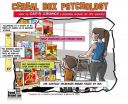(Press-News.org) Improved thinking. Decreased appetite. Lowered blood pressure. The potential health benefits of dark chocolate keep piling up, and scientists are now homing in on what ingredients in chocolate might help prevent obesity, as well as type-2 diabetes. They found that one particular type of antioxidant in cocoa prevented laboratory mice from gaining excess weight and lowered their blood sugar levels. The report appears in ACS' Journal of Agricultural & Food Chemistry.
Andrew P. Neilson and colleagues explain that cocoa, the basic ingredient of chocolate, is one of the most flavanol-rich foods around. That's good for chocolate lovers because previous research has shown that flavanols in other foods such as grapes and tea can help fight weight gain and type-2 diabetes. But not all flavanols, which are a type of antioxidant, are created equal. Cocoa has several different kinds of these compounds, so Neilson's team decided to tease them apart and test each individually for health benefits.
The scientists fed groups of mice different diets, including high-fat and low-fat diets, and high-fat diets supplemented with different kinds of flavanols. They found that adding one particular set of these compounds, known as oligomeric procyanidins (PCs), to the food made the biggest difference in keeping the mice's weight down if they were on high-fat diets. They also improved glucose tolerance, which could potentially help prevent type-2 diabetes. "Oligomeric PCs appear to possess the greatest antiobesity and antidiabetic bioactivities of the flavanols in cocoa, particularly at the low doses employed for the present study," the researchers state.
INFORMATION:
The American Chemical Society is a nonprofit organization chartered by the U.S. Congress. With more than 161,000 members, ACS is the world's largest scientific society and a global leader in providing access to chemistry-related research through its multiple databases, peer-reviewed journals and scientific conferences. Its main offices are in Washington, D.C., and Columbus, Ohio.
To automatically receive news releases from the American Chemical Society, contact newsroom@acs.org.
Follow us: Twitter Facebook
Key chocolate ingredients could help prevent obesity, diabetes
2014-04-02
ELSE PRESS RELEASES FROM THIS DATE:
First peanut genome sequenced
2014-04-02
Athens, Ga. – The International Peanut Genome Initiative—a group of multinational crop geneticists who have been working in tandem for the last several years—has successfully sequenced the peanut's genome.
Scott Jackson, director of the University of Georgia Center for Applied Genetic Technologies in the College of Agricultural and Environmental Sciences, serves as chair of the International Peanut Genome Initiative, or IPGI.
The new peanut genome sequence will be available to researchers and plant breeders across the globe to aid in the breeding of more productive ...
'3D' test could reduce reliance on animals for testing asthma and allergy medications
2014-04-02
To determine whether new medicines are safe and effective for humans, researchers must first test them in animals, which is costly and time-consuming, as well as ethically challenging. In a study published in ACS' journal Molecular Pharmaceutics, scientists report that they've developed a simple, "3D" laboratory method to test asthma and allergy medications that mimics what happens in the body, which could help reduce the need for animal testing.
Amir Ghaemmaghami and colleagues note that respiratory conditions, such as asthma and allergies, are becoming more common. ...
World's oldest weather report could revise Bronze Age chronology
2014-04-02
An inscription on a 3,500-year-old stone block from Egypt may be one of the world's oldest weather reports—and could provide new evidence about the chronology of events in the ancient Middle East.
A new translation of a 40-line inscription on the 6-foot-tall calcite block called the Tempest Stela describes rain, darkness and "the sky being in storm without cessation, louder than the cries of the masses."
Two scholars at the University of Chicago's Oriental Institute believe the unusual weather patterns described on the slab were the result of a massive volcano explosion ...
JCI Online ahead of print table of contents for April 1, 2014
2014-04-02
NOS1 expression predicts melanoma-dependent immune dysfunction
Individuals with cancer often exhibit dysfunctional immune signaling in response to interferon (IFN) stimulation. Furthermore, recent evidence indicates that pSTAT-1 levels, which are indicative of IFN responsiveness, in circulating immune cells are predictive of clinical outcome in melanoma patients. In this issue of the Journal of Clinical Investigation, Qiuzhen Liu and colleagues at Southern Medical University, Guangzhou, China determined that melanoma cells have differing capacity to dampen IFN responses ...
Scientists eager to participate in public discourse on environment
2014-04-02
A survey of more than 500 researchers indicates that scientists have the desire to get more involved in public discussion and policy decisions regarding environmental issues, but have concerns about how their efforts might be perceived.
"Scientists debate whether they have a role in advocacy," says Gerald Singh, a PhD student in the Institute for Resources, Environment and Sustainability at UBC, who conducted the survey with his colleagues. "Some feel they need to remain objective and can't engage. Others feel they have a duty to get involved so that decisions are made ...
Eyes in the cereal aisle -- how Cap'n Crunch's gaze is influencing your purchasing
2014-04-02
Director of Cornell's Food and Brand Lab Brian Wansink and post-doctoral lab researcher Aner Tal, are releasing a new study today published in the Journal of Environment and Behavior that discovered consumers are 16 percent more likely to trust a brand of cereal when the characters on the boxes on the supermarket shelves look them straight in the eye. Not surprisingly, the study also found that the gaze of characters on children's cereal boxes is at a downward, 9.6-degree angle, while characters on adult cereal boxes look almost straight ahead.
Wansink says:
"If you ...
Positive, negative thinkers' brains revealed
2014-04-02
EAST LANSING, Mich. --- The ability to stay positive when times get tough -- and, conversely, of being negative -- may be hardwired in the brain, finds new research led by a Michigan State University psychologist.
The study, which appears in the Journal of Abnormal Psychology, is the first to provide biological evidence validating the idea that there are, in fact, positive and negative people in the world.
"It's the first time we've been able to find a brain marker that really distinguishes negative thinkers from positive thinkers," said Jason Moser, lead investigator ...
Cereal box psychology
2014-04-02
Silly rabbit, Trix are for kids! In a study of 65 cereals in 10 different grocery stores, Cornell researchers found that cereals marketed to kids are placed half as high on supermarket shelves as adult cereals—the average height for children's cereal boxes is 23 inches verses 48 inches for adult cereal. A second key finding from the same study is that the average angle of the gaze of cereal spokes-characters on cereal boxes marketed to kids is downward at a 9.6 degree angle whereas spokes-characters on adult cereal look almost straight ahead.
To examine the influence ...
An easier, safer, and more accurate treatment for pancreatic cancer
2014-04-02
(Lebanon, NH, 4/2/14) — Using CT scans with contrast enhancement, Dartmouth researchers measured treatment response to pancreatic cancer photodynamic therapy (PDT) according to a paper published in Physics in Medicine and Biology.
The research team at Dartmouth set out to reduce the imaging obstacles for PDT, a minimally invasive and nontoxic treatment for cancer. "This study implies that treatment response can be reliably predicted using contrast CT. This would represent a major breakthrough in PDT for pancreas cancer that allows for easier, faster treatment tailored ...
Galactic serial killer
2014-04-02
Several clues in the structure of NGC 1316 reveal that its past was turbulent. For instance, it has some unusual dust lanes [1] embedded within a much larger envelope of stars, and a population of unusually small globular star clusters. These suggest that it may have already swallowed a dust-rich spiral galaxy about three billion years ago.
Also seen around the galaxy are very faint tidal tails — wisps and shells of stars that have been torn from their original locations and flung into intergalactic space. These features are produced by complex gravitational effects on ...





